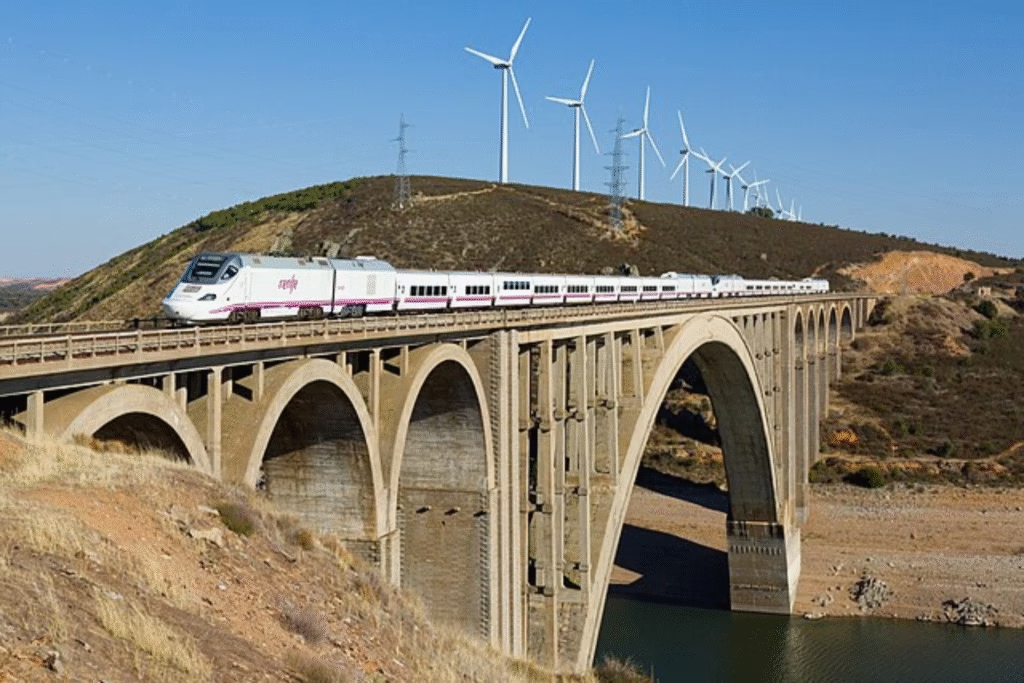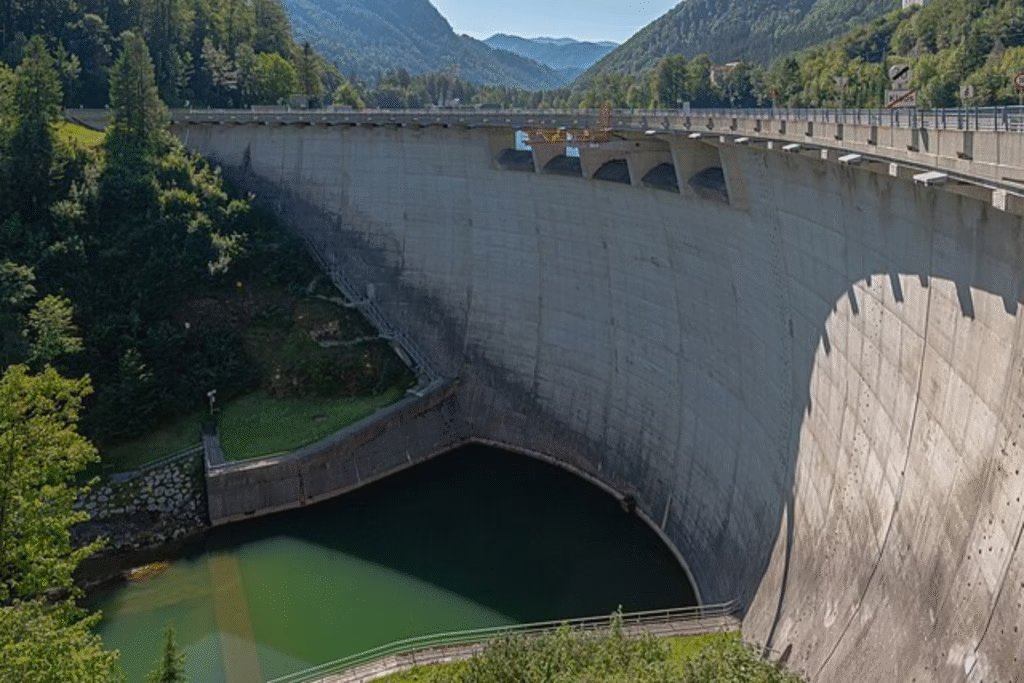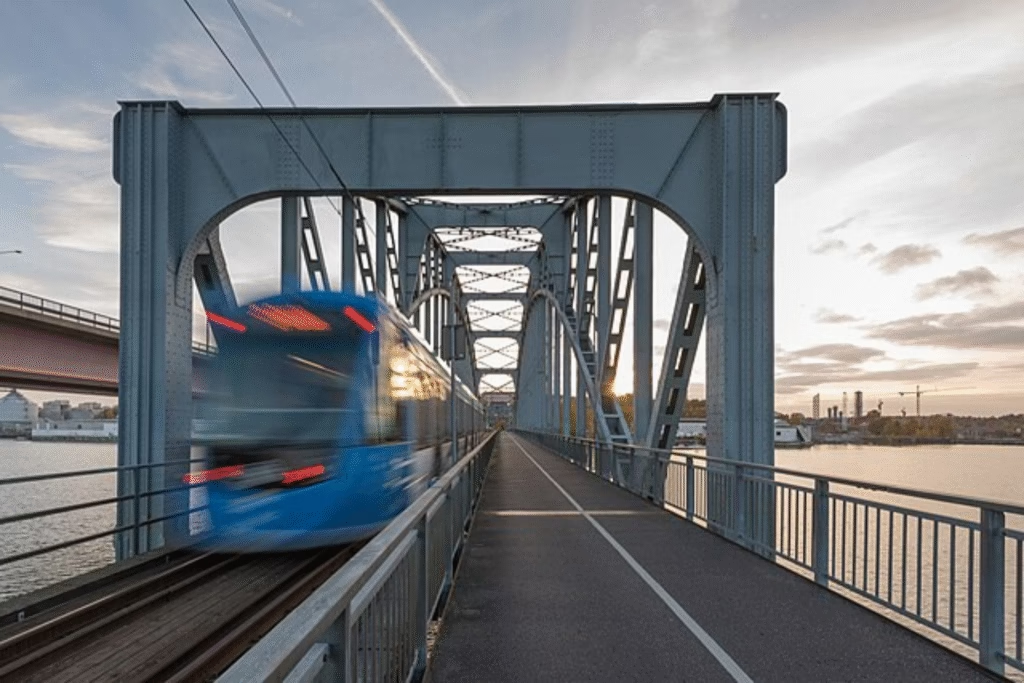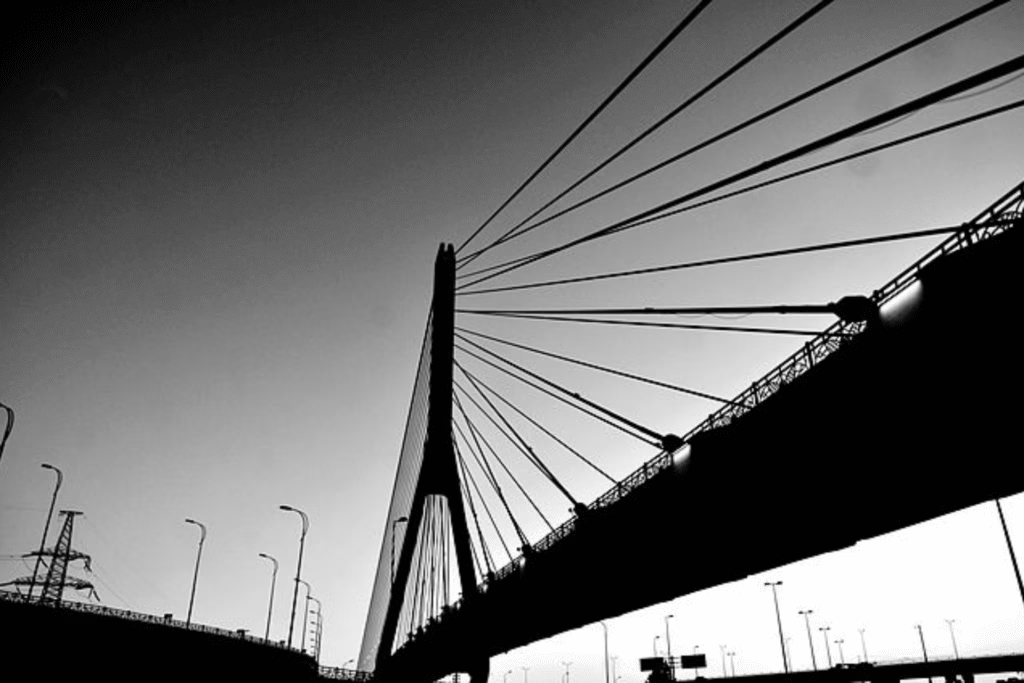Infrastructure economics reveal a startling reality: preventing infrastructure failures costs dramatically less than responding to disasters, yet most infrastructure managers continue investing in reactive approaches that guarantee higher long-term costs.
The economic case for infrastructure prevention is so compelling that the only rational explanation for continued reactive approaches is lack of awareness about the true costs of infrastructure failure.
When decision-makers understand the complete economic picture, infrastructure prevention becomes not just the ethical choice, but the only financially responsible option.

Kabelleger / David Gubler (http://www.bahnbilder.ch)
The True Cost of Infrastructure Failure
Infrastructure failure costs extend far beyond obvious direct expenses like emergency response and reconstruction. These hidden costs often exceed visible expenses by factors of 5-10 times, creating economic devastation that persists for years or decades.
Traditional cost accounting focuses on immediate, visible expenses while ignoring the cascading economic impacts that determine the true cost of infrastructure failure.
This incomplete accounting creates a dangerous illusion that infrastructure failure costs are manageable when the reality is that major failures can bankrupt organizations and communities.
Direct Infrastructure Failure Costs
Direct costs include emergency response, cleanup, temporary repairs, and permanent reconstruction. These costs seem substantial but represent only the beginning of the economic impact.
Emergency response costs can reach millions of dollars within hours as specialized personnel and equipment mobilize to address life safety concerns. Cleanup costs often exceed emergency response as contaminated materials require specialized disposal.
Reconstruction costs typically exceed original construction by 50-200% due to emergency procurement, difficult working conditions, and upgraded design standards.
Business Interruption and Economic Losses
Infrastructure failure disrupts economic activity across entire regions, creating business losses that often exceed direct infrastructure costs. Transportation infrastructure failure affects supply chains worth billions of dollars.
Manufacturing operations face production shutdowns when infrastructure systems fail. The lost production and delayed deliveries create economic impacts that cascade through entire supply chains.
Service sector businesses lose revenue during infrastructure disruptions while facing increased costs for alternative operations. These business impacts persist long after infrastructure is restored.
Community and Social Costs
Infrastructure failure affects entire communities through displaced residents, disrupted services, and damaged social networks. These community costs rarely appear in formal economic analysis but represent substantial economic value.
Housing displacement creates temporary accommodation costs while reducing property values across affected areas. Educational disruption affects children’s development while imposing costs on alternative schooling arrangements.
Healthcare system impacts include treatment for injuries and illnesses related to infrastructure failure plus the costs of disrupted medical services.

valenta
Case Study: The Economics of Preventable Infrastructure Failure
Consider a major bridge carrying 50,000 vehicles daily that experiences catastrophic failure due to undetected foundation problems. Surface inspection showed no concerning conditions, but precision investigation could have identified foundation deterioration years before failure.
Immediate Costs (First 30 Days)
- Emergency response and rescue operations: $5 million
- Traffic rerouting and temporary infrastructure: $15 million
- Bridge debris removal and cleanup: $8 million
- Initial damage assessment and investigation: $2 million
- Total immediate costs: $30 million
Reconstruction Costs (Years 1-3)
- New bridge design and engineering: $25 million
- Bridge construction and materials: $150 million
- Utility relocation and upgrades: $20 million
- Environmental mitigation: $10 million
- Total reconstruction costs: $205 million
Economic Impact Costs (Years 1-5)
- Business losses from traffic disruption: $500 million
- Increased transportation costs: $200 million
- Property value impacts: $150 million
- Tourism and economic development losses: $100 million
- Total economic impact costs: $950 million
Total failure cost: $1.185 billion
Prevention cost comparison:
- Annual precision foundation monitoring: $50,000
- 10-year monitoring program: $500,000
- Foundation stabilization based on monitoring: $15 million
- Total prevention cost: $15.5 million
Return on prevention investment: 76 to 1
This analysis demonstrates why infrastructure prevention always pays: even expensive prevention programs cost less than 2% of failure costs.

Krzysztof Golik
The Economics of Precision Investigation
Precision infrastructure investigation requires upfront investment that provides enormous economic returns through disaster prevention and optimized maintenance scheduling.
Investigation Cost Structure
Precision investigation costs vary with infrastructure complexity and site conditions, but typically range from $5,000-50,000 per investigation depending on scope and techniques required.
These investigation costs seem substantial compared to conventional inspection expenses, but represent tiny fractions of potential failure costs. The economic analysis should compare investigation costs to disaster prevention benefits.
Investigation costs should be viewed as insurance premiums that protect against catastrophic losses rather than expense items that reduce current profitability.
Maintenance Optimization Benefits
Precision investigation enables predictive maintenance scheduling that optimizes infrastructure performance while minimizing costs. This optimization provides economic benefits beyond disaster prevention.
Predictive maintenance reduces emergency repair costs while extending infrastructure service life. The economic benefits of optimized maintenance often exceed investigation costs within 2-3 years.
Condition-based maintenance scheduling reduces unnecessary maintenance activities while ensuring that critical work occurs before failure. This approach typically reduces total maintenance costs by 20-40%.
Asset Lifecycle Economics
Precision investigation enables infrastructure asset management that optimizes total lifecycle costs rather than minimizing initial construction expenses. This lifecycle approach provides substantial long-term economic benefits.
Infrastructure designed and maintained using precision investigation data typically achieves 150-200% of design service life. This extended service life provides enormous economic value through deferred replacement costs.
Lifecycle cost optimization enables strategic infrastructure investment that maximizes economic benefit per dollar invested.
Risk-Based Infrastructure Economics
Infrastructure economic analysis should account for the probability and consequences of failure to determine optimal investment strategies. This risk-based approach enables rational decision-making under uncertainty.
Failure Probability Assessment
Precision investigation provides quantitative data about infrastructure condition and failure probability. This data enables economic analysis based on actual risk rather than assumptions.
Infrastructure failure probability increases exponentially as conditions deteriorate. Early detection through precision investigation enables intervention while failure probability remains low.
Risk assessment should consider multiple failure modes and their relative probabilities to prioritize investigation and maintenance activities effectively.
Consequence Analysis
Infrastructure failure consequences vary dramatically with location, timing, and system interconnections. Economic analysis should account for these consequence variations.
Critical infrastructure serving large populations or essential services justifies higher investigation and maintenance investment due to severe failure consequences.
Consequence analysis should consider cascading impacts through interconnected systems that can multiply the economic impact of initial failures.
Optimal Investment Strategies
Risk-based economic analysis enables optimal infrastructure investment strategies that balance investigation costs against failure risks and consequences.
High-risk, high-consequence infrastructure justifies frequent precision investigation and aggressive maintenance. Low-risk infrastructure may require only periodic monitoring.
Portfolio approaches that optimize investment across entire infrastructure systems provide better economic outcomes than individual project optimization.

Isiwal
Regional Economic Impacts of Infrastructure Decisions
Infrastructure investment decisions affect entire regional economies through direct spending, employment effects, and long-term economic development impacts.
Construction and Investigation Employment
Infrastructure prevention programs create employment for engineers, technicians, and construction workers in high-skill, well-paid positions. These employment effects provide regional economic benefits.
Prevention programs typically create more sustained employment than emergency reconstruction because prevention work occurs consistently over time rather than in crisis periods.
Investigation and monitoring activities require specialized skills that create career advancement opportunities for regional workforces.
Economic Development Implications
Reliable infrastructure enables economic development while infrastructure failure risks discourage business investment. Regional economic development depends on infrastructure reliability.
Businesses consider infrastructure reliability when making location decisions. Regions with comprehensive infrastructure protection programs attract higher-value economic development.
Tourism and other economic activities depend on infrastructure reliability. Infrastructure failures can damage regional economic reputations for years or decades.
Regional Resilience Economics
Infrastructure resilience provides economic value through reduced vulnerability to natural disasters and other disruptions. This resilience value justifies additional investment in infrastructure protection.
Resilient infrastructure systems enable faster economic recovery after disasters. The economic benefits of rapid recovery often exceed the costs of resilience investments.
Regional cooperation in infrastructure protection can enable cost-sharing approaches that make protection programs economically feasible for smaller communities.

Danilo Rozman
Insurance and Infrastructure Economics
Insurance markets provide important signals about infrastructure risk and prevention economics. Insurance industry practices demonstrate the economic value of prevention.
Insurance Cost Implications
Infrastructure operations with comprehensive prevention programs typically qualify for reduced insurance premiums. These premium reductions provide immediate economic benefits that offset prevention costs.
Insurance companies require detailed risk assessment for major infrastructure coverage. Precision investigation provides the data necessary for favorable insurance terms.
Self-insurance programs for large infrastructure owners require accurate risk assessment that depends on precision investigation data.
Risk Transfer Economics
Insurance enables risk transfer that can make infrastructure investment economically feasible. However, risk transfer does not eliminate the need for prevention because insurance excludes many failure consequences.
Business interruption coverage rarely covers all economic impacts of infrastructure failure. The excluded costs often represent the largest economic losses.
Insurance deductibles and coverage limits mean that infrastructure owners bear substantial risk even with comprehensive insurance coverage.
Public Sector Infrastructure Economics
Public sector infrastructure faces unique economic constraints and objectives that affect prevention investment decisions. Public infrastructure economics should consider community benefits that private sector analysis might ignore.
Public Benefit Considerations
Public infrastructure provides community benefits including life safety, environmental protection, and economic development that exceed direct financial returns.
Cost-benefit analysis for public infrastructure should include these community benefits to justify prevention investments that might not meet private sector financial criteria.
Public infrastructure failures create social costs including environmental damage and community displacement that private infrastructure failures might not generate.
Budget and Financing Constraints
Public infrastructure agencies often face annual budget constraints that discourage long-term prevention investments. These budget limitations create false economies that increase total costs.
Innovative financing mechanisms including infrastructure bonds and public-private partnerships can enable prevention investments that provide long-term economic benefits.
Federal and state grant programs often support infrastructure prevention activities that local agencies could not fund independently.
Political Economic Considerations
Infrastructure prevention lacks the political visibility of major construction projects, creating political disincentives for prevention investment despite superior economics.
Infrastructure failures create political crisis that can end political careers. The political risk of infrastructure failure should motivate prevention investment even when economic analysis is ambiguous.
Public education about infrastructure prevention economics can create political support for prevention programs that provide superior long-term value.

Arild Vågen
International Infrastructure Economics
Global infrastructure investment exceeds $3 trillion annually, creating enormous opportunities for prevention-based approaches that improve economic outcomes worldwide.
Developing Nation Infrastructure
Developing nations face infrastructure investment needs that exceed available resources by large margins. Prevention-based approaches can maximize infrastructure value while protecting limited investment resources.
International development funding increasingly emphasizes resilience and prevention rather than initial construction. This shift recognizes the superior economics of prevention-based infrastructure development.
Technology transfer can enable developing nations to implement prevention programs using proven approaches from developed nations.
International Infrastructure Finance
International infrastructure finance institutions increasingly require resilience and prevention components in funded projects. This requirement recognizes the economic benefits of prevention.
Multilateral development banks provide favorable financing terms for infrastructure projects that incorporate comprehensive prevention programs.
Private international infrastructure investment depends on risk assessment that requires precision investigation and monitoring.
Technology Economics in Infrastructure Prevention
Technological advances continue to reduce the costs of precision investigation while improving the accuracy and scope of infrastructure assessment.
Investigation Technology Costs
Investigation technology costs decline consistently while capabilities improve. Modern investigation provides more information at lower costs than historical approaches.
Integration of multiple investigation technologies provides comprehensive assessment at costs that remain small fractions of potential failure costs.
Technological standardization and automation continue to reduce investigation costs while improving consistency and reliability.
Data Management Economics
Infrastructure data management systems enable analysis and reporting that optimize investment decisions. These systems provide economic value through improved decision-making.
Predictive analytics using infrastructure data can forecast optimal maintenance timing while identifying emerging problems before they require expensive intervention.
Data integration across infrastructure portfolios enables system-wide optimization that provides better economic outcomes than individual asset management.

Samir Cabbarov (https://www.flickr.com/photos/samir570/)
Future Infrastructure Economics
Infrastructure economics will continue evolving as climate change, urbanization, and technological change create new challenges and opportunities.
Climate Change Economic Impacts
Climate change increases infrastructure failure risks while creating new failure modes that historical data cannot predict. This uncertainty increases the economic value of prevention and monitoring.
Climate adaptation requires infrastructure investment that provides long-term economic benefits through maintained functionality under changed environmental conditions.
International climate financing provides resources for infrastructure prevention and adaptation that improve economic outcomes for developing nations.
Urbanization Economics
Global urbanization creates infrastructure investment needs while concentrating economic activity in areas vulnerable to infrastructure failure. This concentration increases the economic value of prevention.
Urban infrastructure density creates interdependencies that multiply the economic impacts of individual failures. Prevention becomes more economically justified as urban density increases.
Smart city technologies enable integration of infrastructure monitoring with urban management systems that optimize economic outcomes.
Implementation Economics for Infrastructure Prevention
Organizations seeking to implement infrastructure prevention programs should develop phased approaches that demonstrate economic benefits while building internal capacity.
Pilot Program Economics
Pilot prevention programs should focus on high-risk, high-value infrastructure where economic benefits are most obvious. Success with pilot programs enables expansion to broader infrastructure portfolios.
Pilot programs provide data about prevention program costs and benefits that inform broader implementation decisions.
Demonstration of economic benefits through pilot programs creates organizational and political support for expanded prevention programs.
Scaling Economics
Prevention program costs typically decrease as programs scale due to economies of scope and learning effects. Large-scale prevention programs provide better economic outcomes than individual project approaches.
Regional cooperation in prevention programs can enable cost-sharing that makes prevention economically feasible for smaller organizations.
Standardization of prevention approaches across organizations can reduce costs while improving effectiveness.
Long-term Economic Planning
Infrastructure prevention requires long-term economic planning that considers entire asset lifecycles rather than annual budget cycles.
Capital improvement programming should integrate prevention activities with replacement planning to optimize total economic outcomes.
Economic analysis should consider the compounding benefits of prevention programs that reduce maintenance needs while extending asset life.
Conclusion: The Compelling Economics of Infrastructure Safety
Infrastructure economics provide overwhelming evidence that prevention-based approaches deliver superior long-term economic outcomes compared to reactive maintenance and disaster response. The economic case for precision investigation and preventive intervention is so compelling that continued reactive approaches represent economic malpractice.
Organizations and communities that implement comprehensive infrastructure prevention programs will reduce costs while improving reliability. Those that continue reactive approaches will face escalating costs and increasing failure risks that threaten economic viability.
The choice facing infrastructure decision-makers is clear: invest in prevention now and realize enormous economic benefits, or continue reactive approaches and face inevitable economic disaster. The economic analysis is unambiguous – prevention always pays.
Infrastructure safety is not just an ethical imperative – it’s the most economically rational approach to infrastructure management. The only question is whether decision-makers will act on this economic reality before the next preventable disaster occurs.
FAQs About Infrastructure Economics
What is infrastructure economics?
Infrastructure economics studies the costs and benefits of building, maintaining, and protecting infrastructure, showing that prevention is far cheaper than disaster recovery.
Why does prevention save money in infrastructure economics?
Preventing failures costs a fraction of the expenses of emergency response, reconstruction, and economic losses from business disruption.
How much ROI can infrastructure prevention provide?
Studies show disaster prevention investments can deliver returns of 10 to 100 times their cost due to avoided damage and economic losses.
Who benefits from infrastructure prevention investments?
Communities, governments, and businesses all benefit through reduced costs, improved safety, and stronger regional economies. Prevention protects both financial stability and public safety.
Read other episodes in the Hidden Foundations series:
Episode 1: The 1-Meter Blind Spot: Uncovering Hidden Threats to Infrastructure Safety
Episode 3: Railway Safety: Hidden Dangers Beneath Tracks and the Future of Rail Infrastructure
Episode 5: Heritage Site Preservation: 5 Ways Non-Invasive Investigation Protects Cultural Treasures
Episode 6: Climate Change Infrastructure: 7 Critical Soil Threats Endangering Global Stability
Episode 7: Agricultural Soil Health: How Subsidence and Degradation Threaten Global Food Security
Episode 8: Infrastructure Economics: Why Disaster Prevention Always Pays
Episode 9: Infrastructure Disasters: How Precision Investigation Prevents Repeated Tragedies
Episode 10: Future Infrastructure: How Smart Technology Creates Self-Monitoring Safety Systems
